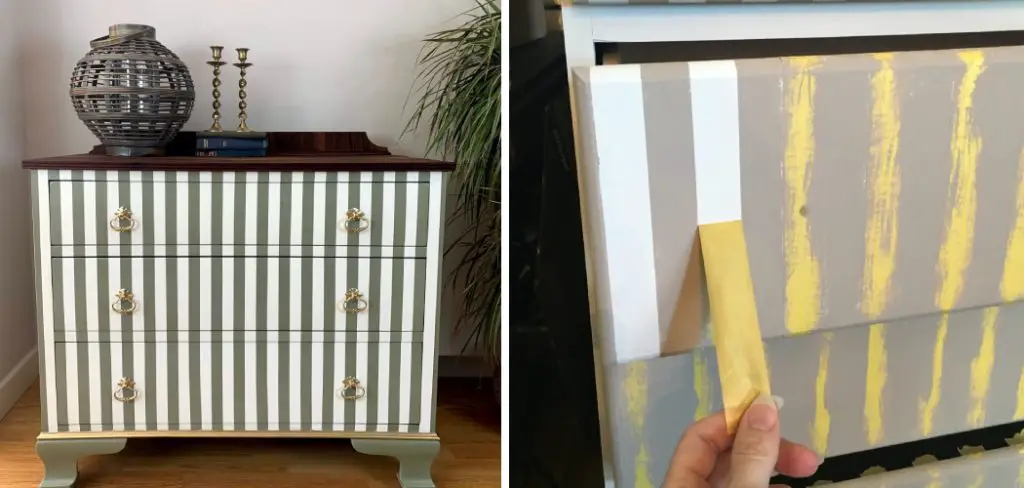Do you often wonder how to add that perfect touch of character to your furniture? Decorating your home with unique and personalized furniture pieces is a great way to enhance your living space, and painting stripes on your furniture is an excellent option for adding a creative touch.

Painting stripes onto furniture can seem daunting, but it’s quite easy with the right approach and technique. In this blog post, we’ll give you some helpful tips and tricks on how to paint stripes on furniture, so you can add a stylish and unique touch to any piece in your home.
Can You Paint Stripes on Furniture?
Adding stripes to furniture can be a fun and creative way to liven up any room. Though it may seem daunting at first, painting stripes on furniture can be a simple and rewarding DIY project. Depending on the look you’re going for, you can stick with traditional colors like black and white or mix it up with bright and bold hues.
The key is to properly measure and tape off your lines to ensure clean and crisp results. So whether you’re looking to add a pop of color or some subtle texture, painting stripes on furniture is a great way to customize your decor and showcase your style.
Why Should You Paint Stripes on Furniture?
When interior decorating, sometimes adding a pattern can transform an entire room. Adding stripes to your furniture is the perfect way to achieve this. Whether vertical or horizontal, stripes add a bold and playful element to your home decor. There are endless possibilities for where to implement this trend – on a dresser, a chair, or even a coffee table.
Stripes can create a cohesive and unified look or bring attention to a specific piece of furniture. Not only do stripes add visual interest, but they can also make a small space appear larger. So why not add a pop of personality to your furniture and try painting some stripes?

Paint Like A Pro: Tips on How to Paint Stripes on Furniture
1. Choosing the Right Paint
First, you must choose the right paint type for your furniture. Acrylic paint is the most popular choice for painting furniture, especially if you’re working with wood or closed pores on the surface.
Choosing the right base and stripe colors is vital, considering their contrast and creating a vision of what you expect from the paint job. Ensure the brand and the finish are compatible, and don’t hesitate to test the colors before embarking on your furniture painting project.
2. Preparing the Surface of Your Furniture
You must prepare your furniture’s surface to get a flawless paint job. This means cleaning any dirt, grime, or dust from the surface using soap and water and letting it dry completely before painting. Take time to mask any areas you do not want to paint.
Remember to sand the furniture’s surface before applying the primer so that the paint sticks to your surface and has a smoother look. Ensure you follow the instructions on the paint can before starting to paint.
3. Paint Stripes on Furniture
Painting stripes on furniture involves a strategic layering of colors and waiting for the contrast to set. First, apply a coat of your base color and let it dry for at least 24 hours. Next, tape your strips according to your desired width, making sure the tape is even and error-free. Now paint the contrast color in the open areas of the furniture piece and let it dry.

You can always add more layers depending on your preference. A tip of great importance is to remove your masking tape as soon as possible before the paint dries completely. This will help you avoid any drooping of the tape from the surface, and your paint job will look crisp at the end.
4. Protect Your Furniture with a Clear Coat
Painting stripes on furniture requires several coats and different layers of paint, so it’s important to protect your work with a clear coat. This way, your paint job will last longer and remain as good as new for years. When the paint has completely dried, use a high-quality sealer or varnish to seal the furniture and protect it from water damage.
5. Don’t Overwork Your Paint
When painting stripes on furniture, it’s important not to overwork your paint job; otherwise, you can end up with an uneven surface or even blemishes. Use short strokes when brushing the paint onto your surface to prevent this. Also, let the paint dry completely before beginning the next layer.
6. Clean Up Your Brushes and Tools
Once you’ve finished painting stripes on your furniture, cleaning up your brushes and tools promptly is important to keep them in good condition for future use. Don’t forget to clean any spills that may have occurred as well.
7. Enjoy the Final Result!
Once your paint job is done, it’s time to sit back and enjoy looking at your beautiful furniture piece with its brand-new stripes! With these tips in mind, you can easily paint stripes on any piece of furniture that needs a little bit of extra flair. So get out there and get painting!
Are you ready to add a stylish touch to your furniture? With these tips, you’ll be an expert in no time. Get creative and have fun with it! It’s the perfect way to upgrade your home decor without breaking the bank. What are you waiting for? Go give those stripes a try! The possibilities are endless. Happy painting!

5 Considerations Things When You Need to Paint Stripes on Furniture
1. Color Selection
When painting stripes on furniture, it is important to choose the right colors for the job. Consider the room’s overall color palette and any other furniture pieces that may be in the same area. It is also important to consider how the colors will look together when choosing colors for stripes. If you are unsure about which colors to use, it can be helpful to consult a color wheel or a design expert for advice.
2. Width of Stripes
The width of your stripes should also be considered when painting furniture. Generally, wider stripes make a bolder statement than narrow ones, while narrower stripes can create an elegant and sophisticated look. It is also important to consider how many stripes you want to paint – too many can make a space look cluttered and busy, while too few can make it look sparse and unfinished.
3. Paint Type & Quality
The type and quality of paint used when painting stripes on furniture is also an important factor to consider. Acrylic paints are often recommended as they are easy to work with and provide good coverage. However, oil-based paints may be a better option if you want a more durable finish.
In either case, it is important to use high-quality paints specifically designed for furniture painting to achieve a professional finish.

4. Prepari,g Furniture Surface
Before beginning any painting project, it is essential to properly prepare the surface of your furniture by cleaning it thoroughly and sanding any imperfections or bumps in the wood surface so that the paint will adhere properly and evenly when applied.
Additionally, using a primer before applying paint will help ensure that your finished product looks smooth and even, with no visible brush strokes or blemishes in the paint job itself.
5. Masking Tape & Other Tools
Finally, when painting stripes on furniture, it is important to use quality masking tape and other tools, such as rulers or stencils, to ensure clean lines between each stripe without any bleeding or smudging of paint onto adjacent areas of the piece of furniture being painted.
Additionally, painter’s tape can help protect other surfaces from accidental splatter from nearby areas when applying multiple coats of paint or different colors within each stripe pattern created on your piece of furniture.
By considering all of these factors, you can achieve a professional-looking paint job for your furniture that impacts any room or space it is placed in. With careful consideration and planning, painting stripes on furniture can lead to stunning visual effects that give your home décor a unique and sophisticated look!
Benefits of Paint Stripes on Furniture
Painting stripes on furniture may seem like a small detail, but it can make a huge impact on the overall look of your home decor. Not only does it add a pop of color and personality to a piece, but it can also create the illusion of length or height, making the furniture appear larger or smaller depending on your desired effect.

Additionally, painted stripes can help to bring together a room that might otherwise feel disjointed by tying in other colors and patterns. So next time you’re considering a furniture update, don’t overlook the power of paint stripes to transform a piece from drab to fab.
Conclusion
Painting stripes on furniture is a fun, inventive, and budget-friendly way to add personality and a touch of uniqueness to your living space. With the tips and techniques outlined in this blog post, you should be able to complete a successful striped painting project that is professional-looking.
Remember, choosing the right paint, keeping the surfaces adequately prepared, painting each stripe systematically, and applying the right coating can create a stunning look to elevate the ambiance of your space. Experiment with different base coats and colors for contrasting stripes and get creative! Thanks for reading our post about how to paint stripes on furniture.
You Can Check It Out to Paint Lace With Acrylics

